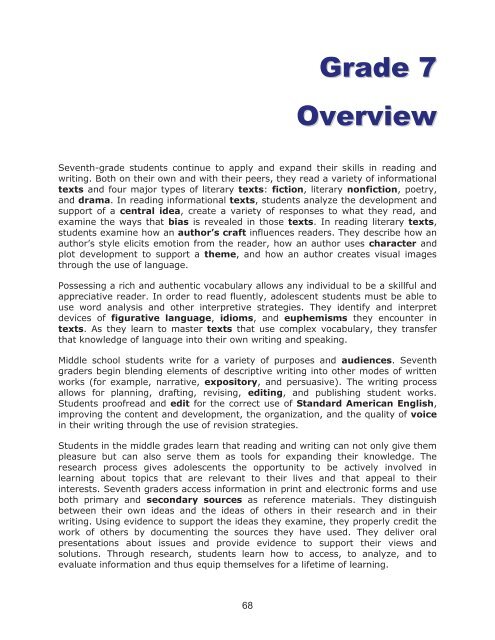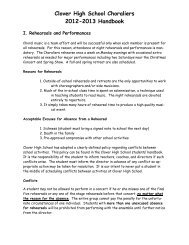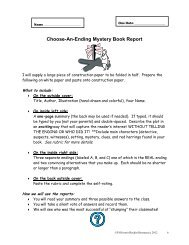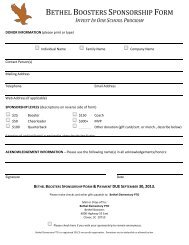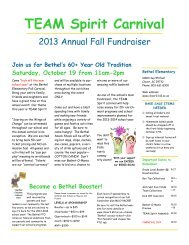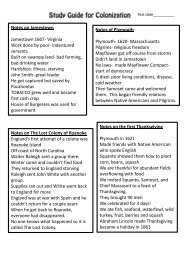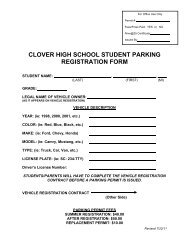SC 7th Grade Standards - Clover School District
SC 7th Grade Standards - Clover School District
SC 7th Grade Standards - Clover School District
You also want an ePaper? Increase the reach of your titles
YUMPU automatically turns print PDFs into web optimized ePapers that Google loves.
<strong>Grade</strong> 7<br />
Overview<br />
Seventh-grade students continue to apply and expand their skills in reading and<br />
writing. Both on their own and with their peers, they read a variety of informational<br />
texts and four major types of literary texts: fiction, literary nonfiction, poetry,<br />
and drama. In reading informational texts, students analyze the development and<br />
support of a central idea, create a variety of responses to what they read, and<br />
examine the ways that bias is revealed in those texts. In reading literary texts,<br />
students examine how an author’s craft influences readers. They describe how an<br />
author’s style elicits emotion from the reader, how an author uses character and<br />
plot development to support a theme, and how an author creates visual images<br />
through the use of language.<br />
Possessing a rich and authentic vocabulary allows any individual to be a skillful and<br />
appreciative reader. In order to read fluently, adolescent students must be able to<br />
use word analysis and other interpretive strategies. They identify and interpret<br />
devices of figurative language, idioms, and euphemisms they encounter in<br />
texts. As they learn to master texts that use complex vocabulary, they transfer<br />
that knowledge of language into their own writing and speaking.<br />
Middle school students write for a variety of purposes and audiences. Seventh<br />
graders begin blending elements of descriptive writing into other modes of written<br />
works (for example, narrative, expository, and persuasive). The writing process<br />
allows for planning, drafting, revising, editing, and publishing student works.<br />
Students proofread and edit for the correct use of Standard American English,<br />
improving the content and development, the organization, and the quality of voice<br />
in their writing through the use of revision strategies.<br />
Students in the middle grades learn that reading and writing can not only give them<br />
pleasure but can also serve them as tools for expanding their knowledge. The<br />
research process gives adolescents the opportunity to be actively involved in<br />
learning about topics that are relevant to their lives and that appeal to their<br />
interests. Seventh graders access information in print and electronic forms and use<br />
both primary and secondary sources as reference materials. They distinguish<br />
between their own ideas and the ideas of others in their research and in their<br />
writing. Using evidence to support the ideas they examine, they properly credit the<br />
work of others by documenting the sources they have used. They deliver oral<br />
presentations about issues and provide evidence to support their views and<br />
solutions. Through research, students learn how to access, to analyze, and to<br />
evaluate information and thus equip themselves for a lifetime of learning.<br />
68
<strong>Grade</strong> 7<br />
READING<br />
Understanding and Using Literary Texts<br />
Standard 7-1<br />
The student will read and comprehend a variety of literary texts<br />
in print and nonprint formats.<br />
Students in grade seven read four major types of literary texts: fiction, literary<br />
nonfiction, poetry, and drama. In the category of fiction, they read the following<br />
specific types of texts: chapter books, adventure stories, historical fiction, contemporary<br />
realistic fiction, science fiction, folktales, tall tales, and myths. In the category of<br />
literary nonfiction, they read personal essays, classical essays, memoirs,<br />
autobiographical and biographical sketches, character sketches, and speeches. In the<br />
category of poetry, they read narrative poems, lyrical poems, humorous poems, free<br />
verse, odes, songs/ballads, and epics.<br />
The teacher should continue to address earlier indicators as they apply to more difficult<br />
texts.<br />
Indicators<br />
7-1.1 Analyze literary texts to draw conclusions and make inferences.<br />
7-1.2 Explain the effect of point of view on a given narrative text.<br />
7-1.3 Interpret devices of figurative language (including extended<br />
metaphor and oxymoron).<br />
7-1.4 Analyze an author’s development of the conflict and the individual<br />
characters as either static, dynamic, round, or flat in a given<br />
literary text.<br />
7-1.5 Interpret the effect of an author’s craft (including tone and the use<br />
of imagery, flashback, foreshadowing, symbolism, and irony) on<br />
the meaning of literary texts.<br />
7-1.6 Analyze a given literary text to determine its theme.<br />
7-1.7 Create responses to literary texts through a variety of methods (for<br />
example, written works, oral and auditory presentations, discussions,<br />
media productions, and the visual and performing arts).<br />
7-1.8 Compare/contrast literary texts from various genres (for example,<br />
poetry, drama, novels, and short stories).<br />
7-1.9 Read independently for extended periods of time for pleasure.<br />
69
<strong>Grade</strong> 7<br />
READING<br />
Understanding and Using Informational Texts<br />
Standard 7-2<br />
The student will read and comprehend a variety of informational<br />
texts in print and nonprint formats.<br />
Students in grade seven read informational (expository/persuasive/argumentative)<br />
texts of the following types: essays, historical documents, informational trade books,<br />
textbooks, news and feature articles, magazine articles, advertisements, encyclopedia<br />
entries, reviews (for example, book, movie, product), journals, and speeches. They also<br />
read directions, maps, time lines, graphs, tables, charts, schedules, recipes, and photos<br />
embedded in informational texts. In addition, they examine commercials, documentaries,<br />
and other forms of nonprint informational texts.<br />
The teacher should continue to address earlier indicators as they apply to more difficult<br />
texts.<br />
Indicators<br />
7-2.1 Analyze central ideas within and across informational texts.<br />
7-2.2 Analyze information within and across texts to draw conclusions and<br />
make inferences.<br />
7-2.3 Identify author bias (for example, word choice and the exclusion and<br />
inclusion of particular information).<br />
7-2.4 Create responses to informational texts through a variety of methods<br />
(for example, drawings, written works, oral and auditory<br />
presentations, discussions, and media productions).<br />
7-2.5 Analyze the impact that text elements (for example, print styles<br />
and chapter headings) have on the meaning of a given informational<br />
text.<br />
7-2.6 Analyze information from graphic features (for example, charts and<br />
graphs) in informational texts.<br />
7-2.7 Identify the use of propaganda techniques (including glittering<br />
generalities and name calling) in informational texts.<br />
7-2.8 Read independently for extended periods of time to gain information.<br />
70
<strong>Grade</strong> 7<br />
READING<br />
Building Vocabulary<br />
Standard 7-3<br />
The student will use word analysis and vocabulary strategies to<br />
read fluently.<br />
The teacher should continue to address earlier indicators as they apply to more difficult<br />
texts.<br />
Instructional appendixes are provided as the baseline expectations for instruction and are<br />
not intended to be all-inclusive documents.<br />
Indicators<br />
7-3.1 Use context clues (for example, those that provide an example, a<br />
definition, a restatement, or a comparison/contrast) to generate the<br />
meanings of unfamiliar and multiple-meaning words.<br />
7-3.2 Analyze the meaning of words by using Greek and Latin roots and<br />
affixes within texts. (See Instructional Appendix: Greek and Latin<br />
Roots and Affixes.)<br />
7-3.3 Interpret the meaning of idioms and euphemisms encountered in<br />
texts.<br />
7-3.4 Interpret the connotations of words to understand the meaning of a<br />
given text.<br />
7-3.5 Spell new words using Greek and Latin roots and affixes. (See<br />
Instructional Appendix: Greek and Latin Roots and Affixes.)<br />
71
<strong>Grade</strong> 7<br />
WRITING<br />
Developing Written Communications<br />
Standard 7-4<br />
The student will create written work that has a clear focus,<br />
sufficient detail, coherent organization, effective use of voice,<br />
and correct use of the conventions of written Standard<br />
American English.<br />
The teacher should continue to address earlier indicators as they apply to more difficult<br />
texts.<br />
Instructional appendixes are provided as the baseline expectations for instruction and are<br />
not intended to be all-inclusive documents.<br />
Indicators<br />
7-4.1 Organize written works using prewriting techniques, discussions,<br />
graphic organizers, models, and outlines.<br />
7-4.2 Use complete sentences in a variety of types (including simple,<br />
compound, complex, and compound-complex).<br />
7-4.3 Create multiple-paragraph compositions that include a central idea<br />
with supporting details and use appropriate transitions between<br />
paragraphs.<br />
7-4.4 Use grammatical conventions of written Standard American English,<br />
including the reinforcement of conventions previously taught. (See<br />
Instructional Appendix: Composite Writing Matrix.)<br />
7-4.5 Revise writing to improve clarity, tone, voice, content, and the<br />
development of ideas. (See Instructional Appendix: Composite Writing<br />
Matrix.)<br />
7-4.6 Edit for the correct use of written Standard American English,<br />
including<br />
ellipses and parentheses. (See Instructional Appendix: Composite<br />
Writing Matrix.)<br />
7-4.7 Spell correctly using Standard American English.<br />
72
<strong>Grade</strong> 7<br />
WRITING<br />
Producing Written Communications in a Variety of Forms<br />
Standard 7-5<br />
The student will write for a variety of purposes and audiences.<br />
The teacher should continue to address earlier indicators as they apply to more difficult<br />
texts.<br />
Indicators<br />
7-5.1 Create informational pieces (for example, book, movie, or product<br />
reviews and news reports) that use language appropriate for a specific<br />
audience.<br />
7-5.2 Create narratives (for example, personal essays or narrative poems)<br />
that communicate the significance of an issue of importance and use<br />
language appropriate for the purpose and the audience.<br />
7-5.3 Create descriptions for use in other modes of written works (for<br />
example, narrative, expository, or persuasive).<br />
7-5.4 Create persuasive pieces (for example, letters to the editor or essays)<br />
that include a stated position with supporting evidence for a specific<br />
audience.<br />
73
<strong>Grade</strong> 7<br />
RESEARCHING<br />
Applying the Skills of Inquiry and Oral Communication<br />
Standard 7-6<br />
The student will access and use information from a variety of<br />
sources.<br />
The teacher should continue to address earlier indicators as they apply to more difficult<br />
texts.<br />
Indicators<br />
7-6.1 Clarify and refine a research topic.<br />
7-6.2 Use direct quotations, paraphrasing, or summaries to incorporate into<br />
written, oral, auditory, or visual works the information gathered from a<br />
variety of research sources.<br />
7-6.3 Use a standardized system of documentation (including a list of<br />
sources with full publication information and the use of in-text<br />
citations) to properly credit the work of others.<br />
7-6.4 Use vocabulary (including Standard American English) that is<br />
appropriate for the particular audience or purpose.<br />
7-6.5 Use appropriate organizational strategies to prepare written works,<br />
oral and auditory presentations, and visual presentations.<br />
7-6.6 Select appropriate graphics, in print or electronic form, to support<br />
written works, oral presentations, and visual presentations.<br />
7-6.7 Use a variety of print and electronic reference materials.<br />
7-6.8 Design and carry out research projects by selecting a topic,<br />
constructing inquiry questions, accessing resources, and selecting and<br />
organizing information.<br />
74


